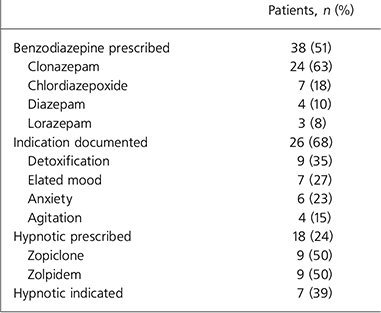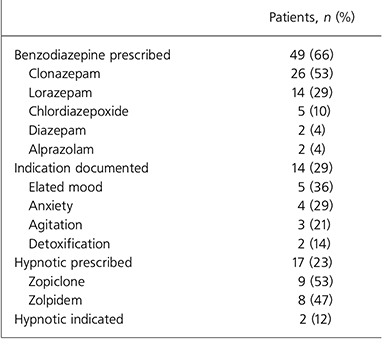Benzodiazepines are widely prescribed in clinical practice but because of their propensity for causing dependence there are several guidelines in place in relation to their administration (British Medical Association & Royal Pharmaceutical Society of Great Britain, 2005; Reference Taylor, Paton and KerwinTaylor et al, 2007). There is also some evidence that non-benzodiazepine hypnotic agents such as zopiclone and zolpidem can lead to misuse and dependence if prescribed for extended periods (Reference Hajak, Muller, Wittchen, Pittrow and KirchHajak et al, 2003). A recent UK study (Reference Choke, Perumal and HowlettChoke et al, 2007) found that 54% of all patients were administered lorazepam in an acute psychiatric in-patient setting. Only one published study to date has examined prescribing practices for both benzodiazepine and hypnotic agents in an acute in-patient setting, and found high rates of both benzodiazepine (83%) and zopiclone (57%) administration (Reference Wheeler, Kairuz, Sheridan and McPheeWheeler et al, 2007).
We aimed in this study to examine both routine and ‘as required’ prescribing of all benzodiazepine and non-benzodiazepine hypnotic agents in an acute in-patient psychiatric setting at a university teaching hospital - University College Hospital, Galway. The psychiatric unit treats patients from both urban (Galway city) and rural (Connemara-West Galway) settings.
Method
Retrospective data were collected from 74 consecutive cases of patients admitted to our psychiatric unit over a 3-month period (June-August 2007). The information extracted from the prescription cards and medical notes for each in-patient included:
-
• patient diagnosis
-
• admission status
-
• whether a benzodiazepine or hypnotic agent was prescribed during the period of admission
-
• whether a clinical indication for the benzodiazepine or hypnotic agent was recorded in the medical notes for routine prescribing, or in the medical notes or the prescription card for ‘as required’ prescribing
-
• names, dosages, diazepam equivalents (Reference Schweizer and RickelsSchweizer & Rickels, 1998) and duration of administration of all medications.
Results
The study sample comprised 43 male (58%) and 31 female (42%) in-patients, with a median age of 43 years (range 19-76; 8 individuals were aged 60 years or over). Twenty-three patients (31%) had been admitted involuntarily. Diagnoses were 20 bipolar affective disorder, 16 recurrent depressive disorder, 13 schizophrenia, 13 schizoaffective disorder, 9 alcohol dependence disorder, 2 polysubstance misuse and 1 adjustment disorder (not related to bereavement). A second psychiatric disorder was present in 12 patients and in 9 cases this was alcohol dependence syndrome. Although our unit provides acute in-patient care (there is a further long-stay ward in another hospital in the same catchment area), only two individuals with schizophrenia or schizoaffective disorder and one individual with bipolar disorder were experiencing the first episode of their illness. Eight individuals (11%) had been taking prescribed benzodiazepines (including both of the patients who were diagnosed as polysubstance misusers) and four individuals (5%) had been taking prescribed hypnotic agents prior to their admission to hospital.
Benzodiazepine prescribing was not associated with the patients’ age or gender, and there was no difference in the routine prescribing rates for individuals admitted on a formal or informal basis. Benzodiazepines were prescribed on an ‘as required’ basis more frequently to informally admitted individuals (P=0.030). There was no difference in any demographic or clinical parameter between individuals who received benzodiazepines routinely or ‘as required’, other than whether the admission was on a formal or informal basis. Benzodiazepine prescribing was not associated with diagnosis except for alcohol dependence syndrome (seven out of nine individuals) and polysubstance misuse (two out of two individuals). Individuals who were prescribed hypnotic agents either routinely (P=0.018) or ‘as required’ (P=0.025) were older than those who were not prescribed these medications. Hypnotic prescribing was not associated with any other demographic or diagnostic parameter. There was no difference in any demographic or clinical parameter between individuals who received hypnotic agents on a routine or an ‘as required’ basis.
Routine benzodiazepine and hypnotic prescribing are detailed in Table 1. Benzodiazepines were prescribed routinely to 38 patients, with clonazepam the most commonly prescribed agent. An indication was recorded in the medical notes in 70% of cases. Hypnotic agents were prescribed routinely in 18 cases with an indication recorded in 39% of cases.
Table 1. Routine prescribing

| Patients, n (%) | |
|---|---|
| Benzodiazepine prescribed | 38 (51) |
| Clonazepam | 24 (63) |
| Chlordiazepoxide | 7 (18) |
| Diazepam | 4 (10) |
| Lorazepam | 3 (8) |
| Indication documented | 26 (68) |
| Detoxification | 9 (35) |
| Elated mood | 7 (27) |
| Anxiety | 6 (23) |
| Agitation | 4 (15) |
| Hypnotic prescribed | 18 (24) |
| Zopiclone | 9 (50) |
| Zolpidem | 9 (50) |
| Hypnotic indicated | 7 (39) |
The prescription of ‘as required’ medications is detailed in Table 2. Benzodiazepines were prescribed to 49 patients and an indication was documented in either the prescription card or the medical notes in 29% of cases. Hypnotics were prescribed to 17 patients and an indication was documented in the prescription card or the medical notes in 12% of cases. Two patients were administered two benzodiazepine agents simultaneously. The mean duration for benzodiazepine prescriptions was 37 days; however, only five patients (13%) received them for more than 4 weeks. Of these individuals, two were being prescribed benzodiazepines as an adjunctive treatment for mania. The mean daily diazepam equivalent dose for those prescribed benzodiazepines was 21.4 mg, and one patient received a benzodiazepine dose (12 mg of clonazepam) greater than that specified in British National Formulary (BNF) guidelines (British Medical Association & Royal Pharmaceutical Society of Great Britain, 2005).
Table 2. ‘As required’ prescribing

| Patients, n (%) | |
|---|---|
| Benzodiazepine prescribed | 49 (66) |
| Clonazepam | 26 (53) |
| Lorazepam | 14 (29) |
| Chlordiazepoxide | 5 (10) |
| Diazepam | 2 (4) |
| Alprazolam | 2 (4) |
| Indication documented | 14 (29) |
| Elated mood | 5 (36) |
| Anxiety | 4 (29) |
| Agitation | 3 (21) |
| Detoxification | 2 (14) |
| Hypnotic prescribed | 17 (23) |
| Zopiclone | 9 (53) |
| Zolpidem | 8 (47) |
| Hypnotic indicated | 2 (12) |
There were a few demographic and clinical differences between individuals receiving benzodiazepine and hypnotic agents. Individuals receiving hypnotic agents were on average 10 years older than those receiving benzodiazepines (age 51 years v. 41 years). Benzodiazepines were prescribed in greater quantities than hypnotics for all psychiatric diagnoses, and in particular for individuals with alcohol dependence, with seven out of nine individuals receiving benzodiazepines whereas only one individual received a hypnotic agent.
Discussion
In this study of an acute in-patient psychiatric ward we found high levels of prescribing of both benzodiazepine and hypnotic agents. Benzodiazepine prescribing was not associated with age, gender or diagnosis (except for treating alcohol withdrawal syndrome) and only ‘as required’ prescribing was more common in informally admitted individuals. The prescribing of hypnotic agents did not differ substantially from that of benzodiazepines, other than the patients being somewhat older and not requiring these medications for medically assisted treatment of alcohol withdrawal.
Although we found high levels of prescribing of both benzodiazepine and hypnotic agents, these rates of prescribing were significantly lower than that found by Wheeler et al (Reference Wheeler, Kairuz, Sheridan and McPhee2007) in a similar patient group. However, no clear indication was recorded in the medical notes or prescription card in many cases, particularly in relation to ‘as required’ medication. Both consultants and registrars can prescribe medication in our acute unit; however, all medication prescribing is regularly reviewed by consultants. Only one patient was prescribed a benzodiazepine agent in excess of the BNF recommended dosing range and no patient received a hypnotic agent in excess of the BNF recommended dosing range.
Benzodiazepines are indicated for less than 4 weeks according to a number of guidelines (National Institute for Health and Clinical Excellence, 2004; British Medical Association & Royal Pharmaceutical Association of Great Britain, 2005; Reference Taylor, Paton and KerwinTaylor et al, 2007), yet 13% of our patients were prescribed these medications for a longer period. In two patients, however, benzodiazepines were prescribed as an adjunctive treatment for mania. The other three patients were prescribed benzodiazepines for longer than 12 weeks, and thus had a significant risk of benzodiazepine dependence.
Mandatory documenting of reasons for prescribing both benzodiazepines and hypnotic agents for ‘as required’ medications should be detailed on the prescription card. We previously noted in our acute psychiatric unit that nursing staff documented a reason for prescribing ‘as required’ medication in 51% of cases (Reference Hallahan, Murray and McDonaldHallahan et al, 2007). We believe that clear indications for prescribing medications on the prescription card by doctors and clear reasons for administering ‘as required’ medications in the patient's notes by nursing staff would decrease inappropriate prescribing and administration of medications including benzodiazepines and hypnotic agents.
Our sample size is modest to draw definitive conclusions; however, we believe that our study and other recent studies (Reference Choke, Perumal and HowlettChoke et al, 2007; Reference Wheeler, Kairuz, Sheridan and McPheeWheeler et al, 2007) demonstrate that the quality of prescribing medication can be improved upon, and that ongoing data collection, review of that data and action in relation to benzodiazepine and hypnotic prescribing are required.
Implications of the study
Benzodiazepine and hypnotic agents are widely prescribed in the acute in-patient psychiatric setting. In many cases no indication is documented for the administration of either benzodiazepines or hypnotics on the prescription card or in the medical notes. This could be rectified with clear hospital guidelines and ongoing audit of benzodiazepine and hypnotic prescribing practices.
Declaration of interest
None.





eLetters
No eLetters have been published for this article.